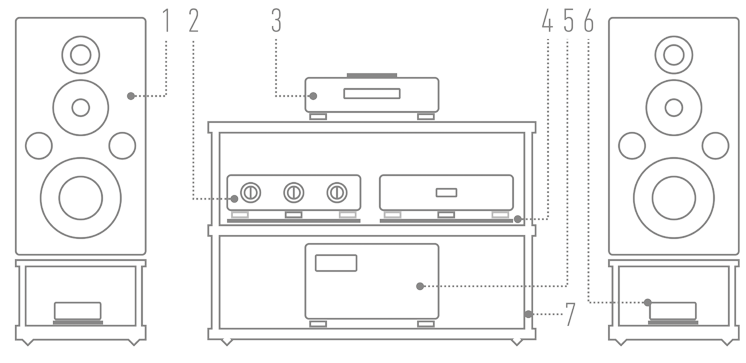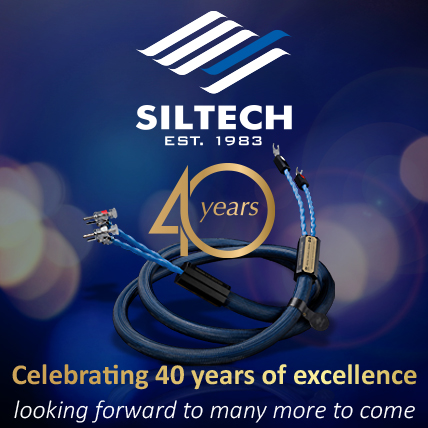|
POWER AMPLIFIERS ⸜ monaural Ancient Audio
Manufacturer: ANCIENT AUDIO |

|
Review
text by WOJCIECH PACUŁA |

|
No 257 October 1, 2025 |
|
˻ PREMIERE ˼ ⌈ Founded in 1995, ANCIENT AUDIO is a Polish company based in Krakow, specializing in high-end electronics, with a focus on tube-based devices. Its offer also includes loudspeakers and solid-state devices. We are premiere-testing the latest product from this manufacturer, the Silver Grand Mono II monoblocks. ⌋ WHEN JAREK WASZCZYSZYN, founder, owner, and designer of Ancient Audio, brought me his top-of-the-line monoblocks, I thought that nothing had really changed. The company, which is celebrating its 30th anniversary this year, still remains a kind of an artistic, handcraft, micro-manufacturer focused on individual customers. In this respect, it resembles similar manufacturers operating in Japan. 
This is a new version of the amplifier called Silver Grand Mono, one that I tested in 2009. Externally, it differs from the previous one in that instead of granite chassis, this time Jarek used milled aluminum blocks. Other than that, everything looks almost the same; you can find the test of the previous version of this amplifier → HERE. It is a tube power amplifier in the form of a mono-block, with a separate external power supply, operating in PSE (Parallel Single Ended) mode with two 300B tubes in the output stage, offering approximately 16 watts of output power per channel. Since 2006, when we first saw this amplifier in its first version, a lot has happened, and inside it is a completely different product. Yes, it is still hand-built using point-to-point technique, i.e. without printed circuit boards, alt-hough there is only one in the power supply section, with bespoke transformers wound with silver wire on the secondary side, designed specifically for this device, and it is still a product aspiring to the top high-end category. I had a chance to find out for myself that these were not exaggerated aspirations by listening numerous times to the previous version of the amplifier at Janusz's place for over a dozen years, during meetings of the Krakow Sonic Society, where they were the most important element of the system. It was the true backbone of the sys-tem, and it was surprising that with each subsequent change that took place in it, Ancient Audio amplifiers showed more and more... ▲ A few simple words… JAROMIR WASZCZYSZYN 
⸜ JAROMIR WASZCZYSZYN with Silver Grand Mono II in „High Fidelity’s” room IN THE THIRTY-YEARS HISTORY OF ANCIENT AUDIO, the Silver Grand Mono amplifier holds a spe-cial place. The first version was created twenty years ago, after six years of work. This amplifier became the company's flagship product and continues to hold that position today. Twenty years is an eternity in electronics, but the changes that occur during this time can result in both progress and regression. Vacuum tubes from the 1960s are considered unmatched, but on the other hand, semiconductor technology continues to race ahead, developing and becoming more complex in accordance with Moore's Law. And the design you have the opportunity to see in this test combines both of these worlds. The first version of this device was recognized by many audiophiles and journalists as the best-sounding ampli-fier on earth at the time. No “buts,” just period. However, this did not change the fact that there is always room for improvement. Finally, after gathering a number of small changes and improvements, the critical mass was exceeded and the time came for the official second version. The most striking feature of version II is the new aluminum chassis, manufactured by our partner company CHAMPION H&C from Taiwan. The interior is a result of a number of small but significant improvements. 
⸜ A prototype of the first version of the amplifier from 2005 • photo by Ancient Audio Amplifiers based on 300B tubes, especially those using a single-ended topology, are incredibly sensi-tive to power supply quality. It is therefore easy to see that the power supply in the Silver Grand Mono II is much more complex than the amplifier itself. This is where the inherent flaw of a directly heated tube becomes apparent, as the full acoustic signal passes through the heating circuit. Therefore, the filament power supply must be of the highest quality. As it turned out, after the modifications, even the cable connecting the power supply to the amplifier became a limitation. The new version therefore has a voltage stabilizer located close to the tubes. Another critical component is the high-voltage power supply. This is because in a single-ended amplifi-er, the power supply not only supplies energy, but also receives it (self-induction of the output transformer). Therefore, the quality of the main capacitors, as energy storage devices, is crucial. That is why, instead of two classic capacitors, as in the first version, in the second version I used a battery of twenty-five fast components. Thanks to this combination, their total series resistance is one hundred times lower. The high-voltage stabilizer can also deliver current pulses several times faster. The fast components must be connected somehow, so the power supply for the second version is wired with high-quality copper, insulated with Teflon. Teflon is one of the best insulating materials (apart from vacuum, of course), as it has a low dielectric constant and no memory effect. That is why this material is also used in my amplifiers as transformer insulation and insulation for V-Cap CuTf capacitors. 
⸜ A final version of the Grand Silver Mono (I) • photo by Ancient Audio The current version of Grand Silver features different signal wiring. As befits a model called Silver, it is made of the purest silver, produced by a fantastic laboratory (I’ll keep which one for myself). However, in-stead of tape, as in version I, I used a series of thin wires, insulated with hard and soft Teflon (Litz cable). Soft Teflon additionally dampens any vibrations, which, contrary to appearances, is extremely important in a tube amplifier. Due to the magnetostriction of the core, the output transformer vibrates, even without speakers con-nected. And these vibrations spread throughout the amplifier. Hence all the fuss with the mechanical design, ap-propriate adhesives, insulators, etc. And now for the most interesting part, namely the question of the final effect. I had the opportunity to compare the previous, but final, “granite” version with a number of improvements installed in it, to the current aluminum version. The first few seconds showed the direction, namely incredible dynamics, energy, and timing. And the rest... We'll see in a moment. The sum of all the carefully selected steps resulted in a completely differ-ent class of sound. 
⸜ Jaromir installing tubes in the new version of the monoblocks During testing, the amplifier was equipped with standard tubes, exactly the same ones any customer will get these amps with. Western Electric, Takatsuki, and other tubes reveal even more music, which is something to keep in mind. However, since the world of SE 300B tube amplifiers is a world of absolute individualists, I did not want to impose my vision on anyone and left the final choice up to them. Nevertheless, the test should show all the basic features of the device, which can then be amplified or weakened independently by using different types of tubes. JW ▌ Silver Grand Mono II THE FIRST PRODUCTS FROM ANCIENT AUDIO were hybrid and tube amplifiers. In later years, the company also specialized in the production of speakers and CD players. I used the → LEKTOR AIR V-EDITION model in my reference system for a long time, but it was the amplifiers, especially the tube amplifiers with directly heated 300B triodes, that were most important to Jaromir. 
From the outset, Silver Grand Mono monoblocks were intended to be “aspirational” devices – for the most expensive audio systems, for the best sound, etc. Costing an incredible PLN 100,000 in 2006, which was unbelievable in Polish reality at the time, they lived up to the hopes placed in them and became a benchmark for many. All the more so because it was a tube amplifier featuring 300B triodes, and thus belonging to a special group of products of this type. The new version utilizes a different chassis, a modified power supply, and numerous improvements in many ar-eas of the design, but the basic principles remain unchanged. It is still a pair of monaural amplifiers, meaning that each channel is played by a separate, monophonic amplifier. The power supplies have been sepa-rated from the main circuit and placed in a separate enclosures. The system therefore consists of four boxes, which should be placed on separate shelves. During the test, I did not have this option, but Jarek approved of placing the amplifiers on the power supplies, which I took advantage of. The amplifier's electrical circuitry is based on four tubes: two double triodes in the preamplifier circuit and two triodes in the output circuit. The first tube is an input buffer, and the second drives the output tubes, which are, respectively, E88CC and ECC83. Both are NOS tubes, meaning they are new but come from old stock. The output tubes, on the other hand, are modern. They are the basic version of the 300B tubes from the Chinese company Psvane. They operate in a parallel single-ended configuration, which allows for lower output impedance (higher output attenuation) and higher power. The manufacturer declares 16 watts per channel. The electronic circuit was assembled using a technique called “point-to-point”. It involves soldering components directly to each other or to pre-prepared “lines”, without the use of printed circuit boards. Many high-end manu-facturers argue that these boards (also known as PCBs) significantly limit sound quality – the signal must run through thin copper tracks applied to the laminate. The method chosen by Jarek Waszczyszyn is ex-tremely time-consuming and requires real craftsmanship, but – as he himself says – “at this level of quality, there is no other option”. Apart from tubes, the amplifiers features bespoke output transformers wound for Ancient Audio with silver secondary windings, which are located in the box visible on the top panel. The coupling between stages is provided by proven, excellent V-Cap CuTF (Copper Foil Fluoropolymer Film) capacitors with Teflon linings and OCC (Ohno Continuous Cast) copper connections in VH Audio's AirLok insulation; I use these capacitors in the Ayon Audio CD-35 HF Edition player. Chris VenHaus, founder and head of the company, writes:
The connections between the gold-plated RCA connectors and the circuit, as well as the speaker output (gold-plated WBT sockets), are made using silver wiring in Teflon. The ground bus bars to which the components are soldered are also silver. These wires are custom-made for Ancient Audio by a laboratory whose name Jarek does not want to reveal. 
The PCBs can be found in the power supply – both in its main section, in a separate housing, and in the amplifi-ers themselves in the voltage stabilization system. Power is supplied by two large toroidal transformers and one smaller, classic transformer (per channel). The filament voltage of the output tubes, the filament voltage of the input tubes, and the anode voltages of the individual tubes are powered separately. All voltages are stabi-lized. |
This time, a battery of thirty small capacitors per channel, instead of two large ones in the previous version of this model, helps to suppress power grid ripple – a total of 160,000 μF. Jarek writes about lower equivalent series resistance (ESR) and faster pulse response – other high-end enthusiasts share this opinion. However, it should be added that not everyone agrees with this line of reasoning. If we look at amplifiers from Accuphase or Ypsilon, we will find powerful, large capacitors in their power supplies. 
The tubes are mounted in Teflon sockets with gold-plated contacts. They are screwed into a solid housing. The latter is made of a single block of aluminum and anodized black. The front panel features ‘windows’ that display the status of the device – at the bottom, whether the power is on, and at the top, whether the bias for the output tubes is correct. The power supply with the amplifier is connected with a thick braided cable ter-minated with a screw-on multi-pin plug. The device does not actually have feet, as Jarek leaves the choice of feet to the end user. While this is understandable in the case of tubes, when it comes to feet, I would rather see something permanently screwed on in this class of devices. For example, Franc Audio Accessories products or the excellent Divine Acoustics Kepler feet. As I said, this is a solidly crafted handmade product. So let's not expect every piece to look identical or be made perfectly. However, each one will be made to order, for a specific person and with a specific system in mind. This is how the top end of the premium market works in every field. ▌ SOUND HOW WE LISTENED • The Ancient Audio Silver Grand Mono II power ampli-fiers were tested in the “High Fidelity” reference system. They were compared to the reference ampli-fier, the Soulution 710 transistor power amplifier – in both cases, the signal was supplied from the Ayon Audio Spheris Evo line preamplifier. During the test, I used the Ayon Audio CD-35 HF Edition SACD player and the Sforzato PCM-05 EX file player with the DSP-05 EX clock as the sources of signal. 
The signal between the preamplifier and amplifiers was transmitted via a RCA Siltech Single Crown in-terconnect, and to the power amplifiers via a Crystal Cable Absolute Dream RCA cable. The signal to the Har-beth M40.1 speakers was delivered via a Crystal Cable Da Vinci speaker cable. The amplifiers were powered us-ing Acoustic Revive Absolute cables. » RECORDINGS USED FOR THE TEST ⸜ a selection
⸜ PAT METHENY, What's It All About, Nonesuch Records/Warner Music Japan WPCR-14176, CD ⸜ 2011. IT'S NOT THAT I CONSIDER the Soulution 710 power amplifier the best amplifier on the planet – absolutely not. However, there is something to this line of thinking, because over the years, during which I lis-tened to hundreds of devices, speakers, and cables with it, I became confident in its outstanding capabilities in almost every aspect. Whether in systems with a turntable, CD player, or in comparison with tube or transistor amplifiers, I have heard its unique qualities every time. That's why it's hard to surprise me with anything. And yet... The Swiss amp offers perfect imaging. Not only does it selectively show everything on a large, deep, and wide sound stage, but it also perfectly presents the bodies of instruments, as well as a kind of tension be-tween them, expressed in the fact that we perceive some of them as larger and more important, and others not. This is complemented by an incredible ability to maintain clarity at high sound levels with recordings with a very high bass content – whether organ recordings in a large church or pop music by Dido. However, the Silver Grand Mono II amplifiers surprised me – precisely with their spatiality. I think I had already forgotten how perfect the first version was in this respect, and that even the wonderful → KONDO ONGAKU couldn't quite match it. I was reminded of this in the first few seconds of ˻ 2 ˺ Cherish, a song from PAT METHENY's album What's It All About. For a moment, I sat there confused, almost certain that I had connected the speakers in reverse phase. The impression was as if the sound surrounded me, which is one of the main features of phase reversal. It was not only “there”, far in the back of the stage, but also around me. I know these tracks perfectly well, I listened to them hundreds of times during testing, and my body was not prepared for something like this, hence my diagnosis: I made a mistake when connecting them. If I had waited a moment longer and not started to check the connections, I would have heard that everything was fine, the phase was correct, and that it was simply the Ancient amplifier showing something that I had not yet heard in y room before. This device is capable of differentiating sound sources in space in an extremely balanced and sophisticated way. Not only can it show that something is further away or closer, but also whether it is larger or smaller, whether it plays in a more intense or freer way, and whether it is – finally – more strongly represented by reflected sounds or less so. And it wasn't just about regular “reverb”, but about the feeling of really “being there”, inside the event. Because it wasn’t about blowing up the space while reducing the clarity of the attack and selectivity. The tested amplifier perfectly defines the instruments in their form and density. So when I played 1 ˺ Midnight Sugar, the title track that opens TSUYOSHI YAMAMOTO TRIO’S album in the recently released SACD version, I got a much more focused sound source, i.e., a clear yet perfectly spacious sound. I knew right away that this was an amplifier that perfectly reproduced low bass. Even with Metheny's baritone guitar, you could feel it, thanks to the large scale of the sound and its anchoring in space. But here, with Isao Fukui's powerful drumming and Tetsuiro Obara's tight double bass, which nevertheless has a lot of reso-nance, it was even more noticeable. The bass from 300B tubes can be excellent, but usually high-efficiency speakers are needed to reveal it in its full scale and power. The Silver Grand Mono II will achieve it even with speakers of regular efficiency. This is something I have been writing about for years and which seems to be slowly filtering into the main-stream: the scale of sound, including basing it on the lower bass, is not directly dependent on the power of the amplifier, but on its current efficiency, both in the long and short term. In fact, it is fast transients that give the impression of abundance and fullness, the illusion of density, and not their sustained “legato”. If some-thing is based on ‘pumping’ the air, it is not selective bass, but a dull “boom” that irritates and disturbs. The tested amplifier is unique in this respect. Even its first version, which I know from Janusz's system and countless nights spent at Kraków Sonic Society, “rocked” the Sonus Faber Electra Amator II speakers like no other amplifier, and at my home it drove the large Harpia Acoustics speakers to levels that would be hard to ex-pect from those dozen or so watts. The “II”, if my memory serves me right, is even better in this respect. This is because you can listen to music really loudly with it without audible compression. Tubes have a tendency to gently enter into overdrive, similar to a tape recorder. And they quickly come out of it. But 300B triodes in circuits that bring out their incredible resolution and dynamics have a smaller overdrive margin than other tubes, i.e., the moment when they start to overdrive until the moment when it becomes clearly audible. In designs such as the Silver Grand Mono II, it is even smaller – here, the aim is to achieve maximum signal transparency to the limits of the tubes themselves, at least that is how I understand it. The Ancient Audio ampli-fier also has a point at which distortion begins to be audible. However, it is so high that when listening to music at a distance of two meters from the speakers in a medium-sized room (25 m2 plus 10 m2), even with such diffi-cult speakers as Harbeths, I could turn up the volume and play loud, without any signs of concern ei-ther from the device or from me. 
This also worked perfectly with THE BEATLES' album Let It Be, remixed in 2021. The sound is much better organized than in the original version, with a much nicer fill. At the same time, it is less “raw”, but that's a discussion for another time. Ancient Audio amplifiers showed this feature right away, from the first kick of the drum in ˻ 1 ˺ Two of Us, filling the room with energy. They also perfectly reproduced the springy reverb superimposed on Lennon's playful, slightly nervous an-nouncement. Interestingly, Ancient did not boost the lower frequencies of this album, which amplifiers com-monly do. It perfectly captured the lower dynamics of these recordings than what I heard on the Three Blind Mice album, as well as a much narrower tonal palette. The differentiation in the performance of this device is incredi-ble – better than anything I've had at home so far. Soulution is also excellent in this respect and better than 99.99% of other devices available on the market. But even it – in such a comparison – slightly flattens dynamic contrasts, both on a micro and macro scale. With all this saturation and the ability to deliver dense bass, truly selective and tonally diverse, Polish monoblocks are not typical “tube” devices. In the sense that if you are looking for “tube warmth”, or whatever it is called on websites and social media these days, you will not find it. Nothing, zip, null, niente. In this respect, the aforementioned Kondo Ongaku, Phasemation MA-1000 or the relatively inexpensive Audio Reveal Classique will be much closer to this ideal. The tested amplifier offers such a perfectly clear sound that there is no “interpretation” of tone. The sound seems fantastically differentiated, as demonstrated by successive albums, whether it was ROY HAYNES QUARTET with Out Of The Afternoon or DIRE STRAITS with Brothers In Arms. 40th Anniversary Edition. Each time, I heard a different story, told in a different language and carrying a different message. The amplifier stops halfway before brightening, maintaining exceptional openness and selectivity. When we hear MILTON NASCIMENTO's low, rich vocals contrasted with ESPERANZA SPALDING's melodi-ous, sweet voice on the album Milton + Esperanza, not only are these differences presented to us clearly, but the vocals are also “united” as they have a common energetic “core” that makes them a kind of uni-ty. The amplifier is capable of showing both the piano with its phase-shifted sound, surrounding us on all sides, and the synthesizer s well as the strings, placed further back in the mix and on the stage, and the lead vo-cals not far in front of us. That is why listening to music with this amplifier never gets boring. The amount of detail does not overwhelm us or tire us, although it should be noted – I repeat – that this is not a “warm” sound. Each time, we get something “extra,” something “more”. It is obvious that after some time we will get used to it and, apart from a disgusted expression on our face when listening to the systems of our audiophile friends, we will be satu-rated with the differentiation offered by the Silver Grand Mono II. But that is precisely why each subsequent lis-tening to a record we know perfectly well will be an experience. ▌ Summary KNOWING WHAT KIND OF POWER is offered by the Polish amplifiers and being familiar with the perfor-mance of 300B tubes in other designs, you will be deeply impressed by how perfectly this device repro-duces bass, not only with audiophile recordings, but also with music by KINGDM, DIDO, SCARLET PLEAS-URE, or ANYMA (the excellent track Voices In My Head). And this bass is differentiated in terms of tone, dynamics, and sound scale. At the same time, however, it will not be “fat” or as low set in the sound mass as with amplifiers such as the Soulution 710, for example. The Silver Grand Mono II monoblocks focus on differentiation, resolu-tion, tonal dynamics, and energy. They do not discriminate against poorer-sounding recordings and handle eve-ry type of music perfectly, really every type. They try to bring out what is really interesting in them, without cov-ering up their weaker points. That is why it may not be an amplifier “for everyone”; you have to know what you want from life. 
And yet, by freely communicating signal compression and the associated distortion, these Polish amplifiers draw our attention to recordings in which everything is in its place. So we will be looking for better and better versions, editions, and copies. Jarek Waszczyszyn's device is a top-of-the-line device, a machine that transforms the signal from the sound source into a language that the speakers can understand. Perfectly clear and dynamic, perfectly spacious and with bass that most amplifiers with 100 watts output and more can only dream of. It's powerful! Well-deserved ˻ GOLD FINGERPRINT ˺. ● ▌ Technical specifications (according to the manufacturer):
• Amplifier type: Parallel Single Ended Triode 
THIS TEST HAS BEEN DESIGNED ACCORDING TO THE GUIDELINES adopted by the Association of International Audiophile Publications, an international audio press association concerned with ethical and professional standards in our industry, of which HIGH FIDELITY is a founding member. More about the association and its constituent titles → HERE. |

|
Reference system 2025 |
|
 1) Loudspeakers: HARBETH M40.1 |REVIEW| 2) Line preamplifier: AYON AUDIO Spheris III Linestage |REVIEW| 3) Super Audio CD Player: AYON AUDIO CD-35 HF Edition No. 01/50 |REVIEW| 4) Stands (loudspeakers): ACOUSTIC REVIVE (custom) |ABOUT| 5) Power amplifier: SOULUTION 710 6) Loudspeaker filter: SPEC REAL-SOUND PROCESSOR RSP-AZ9EX (prototype) |REVIEW| 7) Hi-Fi rack: Hi-Fi rack: finite elemente MASTER REFERENCE PAGODE EDITION Mk II, more → HERE |
|

|
Cables Analog interconnect SACD Player - Line preamplifier: SILTECH Triple Crown (1 m) |ABOUT|» ANALOG INTERCONNECT Line preamplifier → Power amplifier: Siltech ROYAL SINLGE CROWN RCA; review → HERE Speaker cable: SILTECH Triple Crown (2.5 m) |ABOUT| |

|
AC Power Power cable | Mains Power Distribution Block - SACD Player: SILTECH Triple CrownPower (2 m) |ARTICLE| » POWER CABLE Mains Power Distribution Block → Line preamplifier: Acoustic Revive ABSOLUTE-POWER CORD, review → HERE » POWER CABLE Mains Power Distribution Block → Power amplifier: Acoustic Revive ABSOLUTE-POWER CORD, review → HERE Power cable | Power Receptacle - Mains Power Distribution Block: ACROLINK Mexcel 7N-PC9500 (2 m) |ARTICLE| Power Receptacle: Acoustic Revive RTP-4eu ULTIMATE |REVIEW| » ANTI-VIBRATION PLATFORM under Acoustic Revive RTP-4eu ULTIMATE: Graphite Audio CLASSIC 100 ULTRA, review → HERE Power Supply Conditioner: Acoustic Revive RPC-1 |REVIEW| Power Supply Conditioner: Acoustic Revive RAS-14 Triple-C |REVIEW| Passive filter EMI/RFI: VERICTUM Block |REVIEW| |

|
Anti-vibration Speaker stands: ACOUSTIC REVIVE (custom)Hi-Fi rack: finite elemente MASTER REFERENCE PAGODE EDITION Mk II, more → HERE Anti-vibration platforms: ACOUSTIC REVIVE RAF-48H |ARTICLE| » ANTI-VIBRATIONAL FEET: |

|
Analogue Phono preamplifier: Phono cartridges:
Clamp: PATHE WINGS Titanium PW-Ti 770 | Limited Edition Record mats:
|

|
Headphones » HEADPHONE AMPLIFIER: Leben CS-600X, review → HEREHeadphones: Headphone Cables: Forza AudioWorks NOIR HYBRID HPC |
main page | archive | contact | kts
© 2009 HighFidelity, design by PikselStudio,
projektowanie stron www: Indecity






























